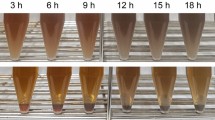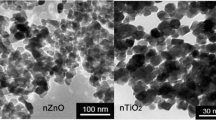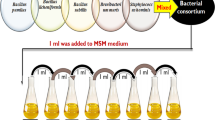Abstract
Disinfection of water and wastewater strongly contributes to solving the problem of water shortage in arid/semi-arid areas; cheap and ecofriendly approaches have to be used to meet water quality standards. In the present study, a green synthesis of iron nanoparticles (INPs) under aerobic and anaerobic conditions via nitrate reductases (NAP/NAR) enzymes produced by Proteus mirabilis strain 10B were employed for this target. The biosynthesized INPs were characterized; UV-Vis spectroscopy revealed surface plasmon resonance at 410 (aerobic) and 265 nm (anaerobic). XRD indicated crystalline magnetite ((MNPs) aerobically synthesized) and zerovalent INPs (ZVINPs anaerobically synthesized). EDX demonstrated strong iron signal with atomic percentages 73.3% (MNPs) and 61.7% (ZVINPs). TEM micrographs illustrated tiny, spherical, periplasmic MNPs (1.44–1.92 nm) and cytoplasmic ZVINPs with 11.7–60.8 nm. Zeta potential recorded − 31.8 mV (ZVINPs) and − 66.4 mV (MNPs) affirming colloidal stability. Moreover, the disinfection power of INPs was evaluated for standards organisms and real water (fresh, sea and salt mine) and wastewater (municipal, agricultural and industrial) samples. The results reported that INPs displayed higher antagonistic effect than iron precursor, 700 and 850 μg/mL of MNPs and ZVINPs, respectively, was sufficient to show a drastic algicidal effect on algal growth. Both types of INPs demonstrated obvious dose-dependent antibiofilm efficiency. Due to their smaller size, MNPs were more efficient than ZVINPs at the suppression of microbial growth in all examined water samples. Overall, MNPs showed superior antagonistic activity, which promotes their exploitation in enhancing water/wastewater quality.








Similar content being viewed by others
References
Abdeen M, Sabry S, Ghozlan H, El-Gendy A, Carpenter E (2016) Microbial-physical synthesis of Fe and Fe3O4 magnetic nanoparticles using Aspergillus niger YESM1 and supercritical condition of ethanol. J Nanomater 2016:1–7. https://doi.org/10.1155/2016/9174891
Adin A, Asano T (1998) The role of physical chemical treatment in wastewater reclamation and reuse. Water Sci Technol 37(10):79–80. https://doi.org/10.2166/wst.1998.0381
Aoki K, Shinke R, Nishira H (1981) Isolation and identification of respiratory nitrate reductase-producing bacteria from soli and production of enzyme. Agric Biol Chem 45(4):817–822. https://doi.org/10.1080/00021369.1981.10864630
Bagbi Y, Sarswat A, Mohan D, Pandey A, Solanki P (2017) Lead and chromium adsorption from water using L-cysteine functionalized magnetite (Fe3O4) nanoparticles. Sci Rep 7(1):7672. https://doi.org/10.1038/s41598-017-03380-x
Baghani A, Mahvi A, Gholami M, Rastkari N, Delikhoon M (2016) One-pot synthesis, characterization and adsorption studies of amine-functionalized magnetite nanoparticles for removal of Cr (VI) and Ni (II) ions from aqueous solution: kinetic, isotherm and thermodynamic studies. J Environ Health Sci Eng 14(11):1–12. https://doi.org/10.1186/s40201-016-0252-0
Barhoumi L, Dewez D (2013) Toxicity of superparamagnetic iron oxide nanoparticles on green alga Chlorella vulgaris. Biomed Res Int 2013:1–11. https://doi.org/10.1155/2013/647974
Butler C, Charnock J, Garner C, Thomson A, Ferguson S, Richardson D (2000) Thiocyanate binding to the molybdenum centre of the periplasmic nitrate reductase from Paracoccus pantotroph. Biochem J 352(3):859–864. https://doi.org/10.1042/bj3520859
Carter J, Richardson D, Spiro S (1995) Isolation and characterization of a strain of Pseudomonas putida that can express periplasmic nitrate reductases. Arch Microbiol 163(3):159–166. https://doi.org/10.1007/BF00305348
D'Alessandro B, Lery L, von Krüger W, Lima A, Piccini C, Zunino P (2011) Proteomic analysis of Proteus mirabilis outer membrane proteins reveals differential expression in vivo vs. in vitro conditions. FEMS Immunol Med Microbiol 63(2):174–182. https://doi.org/10.1111/j.1574-695X.2011.00839.x
Drtil M, Nemeth P, Kucman K, Bodik I, Kasperek V (1995) Acidobasic balances in the course of heterotrophic denitrification. Water Res 29(5):1353–1360. https://doi.org/10.1016/0043-1354(94)00228-Y
Elblbesy M, Madbouly A, Hamdan T (2014) Bio-synthesis of magnetite nanoparticles by bacteria. Am J Nano Res Appl 2(5):98–103. https://doi.org/10.11648/j.nano.20140205.12
Elkady MF, Farag S, Zaki S, Abu-Elreesh G, Abd- El-Haleem D (2011) Bacillus mojavensis strain 32A, a bioflocculant producing bacterium isolated from an Egyptian salt production pond. Bioresour Technol 102(17):8143–8151. https://doi.org/10.1016/j.biortech.2011.05.090
Elrashdy R, Abd-El-Haleem D (2005) Molecular analysis of cross-bacterial contamination detected during diagnosis HCV infection. J Appl Sci Environ Manag 9:5–10
Eltarahony M, n.d.Zaki S, Kheiralla Z, Abd-El-haleem D (2015) Isolation, characterization and identification of nitrate reductase producing bacteria. Int J Recent Sci Res 7 (11): 7225-7233.
Fischer A, Schmitz M, Aichmayer B, Fratzl P, Faivre D (2011) Structural purity of magnetite nanoparticles in magnetotactic bacteria. J R Soc Interface 8(60):1011–1018. https://doi.org/10.1098/rsif.2010.0576
Flanagan D, Gregory L, Carter J, Karakas-Sen A, Richardson D, Spiro S (1999) Detection of genes for periplasmic nitrate reductase in nitrate respiring bacteria and in community DNA. FEMS Microbiol Lett 177(2):263–270. https://doi.org/10.1111/j.1574-6968.1999.tb13742.x
Franci G, Falanga A, Galdiero S, Palomba L, Rai M, Morelli G, Galdiero M (2015) Silver nanoparticles as potential antibacterial agents. molecules 20(5):8856–8874. https://doi.org/10.3390/molecules20058856
Giordani R, Buc J, Cornish-Bowden A, Cárdenas M (1997) Kinetics of membrane-bound nitrate reductase A from Escherichia coli with analogues of physiological electron donors. Different reaction sites for menadiol and duroquinol. Eur J Biochem 250:567–577. https://doi.org/10.1111/j.1432-1033.1997.0567a.x
Gong N, Shao K, Feng W, Lin Z, Liang C, Sun Y (2011) Biotoxicity of nickel oxide nanoparticles and bio-remediation by microalgae Chlorella vulgaris. Chemistry 83:510–516. https://doi.org/10.1016/j.chemosphere.2010.12.059
Gordon T, Perlstein B, Houbara O, Felner I, Banin E, Margel S (2011) Synthesis and characterization of zinc/iron oxide composite nanoparticles and their antibacterial properties. Colloids Surf A Physicochem Eng Asp 374(1-3):1–8. https://doi.org/10.1016/j.colsurfa.2010.10.015
Gupta M, Gahlot R, Nigam C, Kumar V (2013) Biofilm: detection methods and correlation with antimicrobial resistance in Staphylococcus nation. J Labor Med 2(2):7–10
Hari T, Montazer M (2014) TiO2/hematite or magnetite/Ag nanoparticles synthesized on polyester fabric at various temperatures producing different superparamagnetic, self-cleaning and antibacterial textiles. Sci Iran 21(6):2490–2498
Hazeem L, Waheed F, Rashdan S, Bououdina M, Brunet L, Slomianny C, Boukherroub R, Elmeselmani W (2015) Effect of magnetic iron oxide (Fe3O4) nanoparticles on the growth and photosynthetic pigment content of Picochlorum sp. Environ Sci Pollut Res 22(15):11728–11739. https://doi.org/10.1007/s11356-015-4370-5
He D, Hughes S, Vanden-Hehir S, Georgiev A, Altenbach K, Tarrant E, Logan Mackay C, Waldron K, Clarke D, Marles-Wright J (2016) Structural characterization of encapsulated ferritin provides insight into iron storage in bacterial nanocompartments. eLife 5
Ibrahem K, Salman J, Ali F (2014) Effect of titanium nanoparticles biosynthesis by Lactobacillus crispatuson urease, haemolysin, biofilm forming by some bacteria causing recurrent UTI in Iraqi women. Eur Sci J 10(9):324–338
Iconaru S, Prodan A, Le Coustumer P, Predoi D (2013) Synthesis and antibacterial and antibiofilm activity of iron oxide glycerol nanoparticles obtained by coprecipitation method. J Chemother 2013:1–6. https://doi.org/10.1155/2013/412079
Jarockyte G, Daugelaite E, Stasys M, Statkute U, Poderys V, Tseng T, Hsu S, Karabanovas V, Rotomskis R (2016) Accumulation and toxicity of superparamagnetic iron oxide nanoparticles in cells and experimental animals. Int J Mol Sci 17(8):1193. https://doi.org/10.3390/ijms17081193
Jun Y (2011) Effect of protein crud extract on oxic/anoxic diauxic growth of a NAP-deficient mutant of Paracoccus pantatrophus. M.Sc. thesis. University of Florida
Kanagasubbulakshmi S, Kadirvelu K (2017) Green synthesis of iron oxide nanoparticles using lagenaria siceraria and evaluation of its antimicrobial activity. Defen Life Sci J 2(4):422–427. https://doi.org/10.14429/dlsj.2.12277
Karman S, Diah S, Gebeshuber I (2015) Raw materials synthesis from heavy metal industry effluents with bioremediation and phytomining: a biomimetic resource management approach. Adv Mater Sci Eng 2015(3):1–21. https://doi.org/10.1155/2015/185071
Katepetch C, Rujiravanit R (2011) Synthesis of magnetic nanoparticle into bacterial cellulose matrix by ammonia gas-enhancing in situ co-precipitation method. Carbohydr Polym 86(1):162–170. https://doi.org/10.1016/j.carbpol.2011.04.024
Keat C, Aziz A, Eid A, Elmarzugi N (2015) Biosynthesis of nanoparticles and silver nanoparticles. Bioresour Bioprocess 2(47):1–11. https://doi.org/10.1186/s40643-015-0076-2
Kirchman DL, Hoffman KA, Weaver R, Hutchins DA (2003) Regulation of growth and energetics of a marine bacterium by nitrogen source and iron availability. Mar Ecol Prog Ser 250:291–296. https://doi.org/10.3354/meps250291
Klueglein N, Zeitvogel F, Stierhof Y, Floetenmeyer M, Konhauser K, Kappler A, Obst M (2013) Potential role of nitrite for abiotic Fe(II) oxidation and cell encrustation during nitrate reduction by denitrifying bacteria. Appl Environ Microbiol 80(3):1051–1061. https://doi.org/10.1128/AEM.03277-13
Krawczyk-Balska A, Lipiak M (2013) Critical role of a ferritin-like protein in the control of listeria monocytogenes cell envelope structure and stability under b-lactam pressure. PLoS One 8(10):1–10. https://doi.org/10.1371/journal.pone.0077808
Krutisova T, Hejna J, Pekar M (2015) Nanoparticles formed by self-assembly of negatively charged hyaluronan and cationic surfactant. NanoCon. 18:10–16
Kumari R, Barsainy M, Singh D (2017) Biogenic synthesis of silver nanoparticle by using secondary metabolites from Pseudomonas aeruginosa DM1 and its anti-algal effect on Chlorella vulgaris and Chlorella pyrenoidosa. Environ Sci Pollut Res 24(5):4645–4654. https://doi.org/10.1007/s11356-016-8170-3
Levy-Booth DJ, Prescott CE, Grayston SJ (2014) Microbial functional genes involved in nitrogen fixation, nitrification and denitrification in forest ecosystems Soil. Biol Biochem 75:11–25 https://www.researchgate.net/deref/http%3A%2F%2Fdx.doi.org%2F10.1016%2Fj.soilbio.2014.03.021
Li Y, Katzmann E, Borg S, Schüler D (2012) The periplasmic nitrate reductase nap is required for anaerobic growth and involved in redox control of magnetite biomineralization in magnetospirillum gryphiswaldense. J Bacteriol 194(18):4847–4856. https://doi.org/10.1128/JB.00903-12
Lin I, Lok C, Che C (2014) Biosynthesis of silver nanoparticles from silver (I) reduction by the periplasmic nitrate reductase c-type cytochrome subunit NapC in a silver-resistant E. coli. Chem Sci 5(8):3144–3150. https://doi.org/10.1039/C4SC00138A
Ma Z, David F, Giedroc P (2009) Metal transporters and metal sensors: how coordination chemistry controls bacterial metal homeostasis. Chem Rev 109(10):4644–4681. https://doi.org/10.1021/cr900077w
Mahdavi M, Namvar F, Bin Ahmad M, Mohamad R (2013) Green biosynthesis and characterization of magnetic iron oxide (Fe3O4) nanoparticles using seaweed (Sargassum muticum). Aqueous Extract. Molecules 18(5):5954–5964. https://doi.org/10.3390/molecules18055954
Maheswari KC, Reddy PS (2016) Green synthesis of magnetite nanoparticles through leaf extract of Azadirachta indica. J Nanosci Technol 2(1):189–191
Mateus G, Paludo M, Santos T, Silva M, Nishi L, Fagundes-Klen M, Gomes R, Bergamasco R (2018) Obtaining drinking water using a magnetic coagulant composed of magnetite nanoparticles functionalized with Moringa oleifera seed extract. J Environ Chem Eng 6(4):4084–4092. https://doi.org/10.1016/j.jece.2018.05.050
Minaeian S, Shahverdi R, Nohi A, Shahverdi H (2008) Extracellular biosynthesis of silver nanoparticles by some bacteria. J Sci I AU (JSIAU) 17:1–4
Miot J, Remusat L, Duprat E, Gonzalez A, Pont S (2015) Fe biomineralization mirrors individual metabolic activity in a nitrate-dependent Fe(II)-oxidizer. Front Microbiol 6(1-13). https://doi.org/10.3389/fmicb.2015.00879
Nabawy A, Hassan A, Sayed El-Ahl R, Refai M (2014) Effect of metal nanoparticles in comparison with commercial antifungal feed additives on the growth of Aspergillus flavus and aflatoxin B1 production. J Glob Biosci 3(6):954–971
Nathan M, Suganya R (2018) Investigation on the morphological and magnetic properties of Fe3O4 nanoparticles for biomedical applications. Int J Pure Appl Math 119(12):6515–6524
Nygren C, Eberhardt U, Karlsson M, Parrent J, Lindahl B, Taylor A (2008) Growth on nitrate and occurrence of nitrate reductase encoding genes in a phylogenetically diverse range of ectomycorrhizal fungi. New Phytol 180(4):875–889. https://doi.org/10.1111/j.1469-8137.2008.02618.x
Pal S (2014) Antimicrobial activity of iron oxide nanoparticles M.Sc. in life science—National Institute of technology Roukela, Orissa, Indi.
Pande N, Jaspal D, Malviya A, Jayachandran V (2015) Green route synthesis of iron nanoparticles and antibacterial studies. Int J Adv Sci Eng Technol 3(2):98–102
Park BS, Song DH, Kim HM, Choi BS, Lee H, Lee JO (2009) The structural basis of lipopolysaccharide recognition by the TLR4-MD-2 complex. Nature. 458(7242):1191–1195. https://doi.org/10.1038/nature07830
Prakash A, Sharma S, Ahmad N, Ghosh A, Sinha P (2010) Bacteria mediated extracellular synthesis of metallic nanoparticles. Int Res J Biotechnol 1(5):071–079
Prodan A, Iconaru S, Chifiriuc C, Bleotu C, Ciobanu C, Motelica-Heino M, Sizaret S, Predoi D (2013) Magnetic properties and biological activity evaluation of iron oxide nanoparticles. J Nanomater 2013:1–7. https://doi.org/10.1155/2013/893970
Pulit-Prociak LJ, Banach M (2016) Silver nanoparticles a material of the future? Open Chemist 14(1):76–91. https://doi.org/10.1515/chem-2016-0005
Rafi M, Ahmed K, PremNazeer K, Kumar D (2015) Antibacterial activity of iron oxide nanoparticles on polysaccharide templates: synthesis, characterization and magnetic studies Malays. Polym J 10(1):16–22
Ramanathan R, Field M, O’Mullane A, Smooker P, Bhargava S, Bansal B (2013) Aqueous phase synthesis of copper nanoparticles: a link between heavy metal resistance and nanoparticle synthesis ability in bacterial systems. Nanoscal 5(6):2300–2306. https://doi.org/10.1039/c2nr32887a
Rashmi S, Madhu G, Kittura A, Suresh R (2013) Synthesis, characterization and application of zero valent iron nanoparticles for the removal of toxic metal hexavalent chromium [Cr(VI)] from aqueous solution. Int J Curr Eng Technol:37–42
Robin G, Namasivaym S, Raju S (2013) Synthesis, characterization and antibacterial activity of chitosan stabilized nano zero valant iron. Bull Pharm Med Sci 1(1):7–11
Roussel-Delif L, Tarnawski S, Hamelin J, Philippot L, Aragno M, Fromin N (2005) Frequency and diversity of nitrate reductase genes among nitrate-dissimilating Pseudomonas in the rhizosphere of perennial grasses grown in field conditions. Microb Ecol 49(1):63–72. https://doi.org/10.1007/s00248-003-0228-3
Ruiz-Torres C, Araujo-Martínez R, Martínez-Castañ ón G, Morales-Sánchez J, Guajardo-Pacheco J, González-Hernández J, Lee T-J, Shin H-S, Hwang Y, Ruiz F (2017) Preparation of air stable nanoscale zero valent iron functionalized by ethylene glycol without inert condition. Chem Eng J 336:112–122. https://doi.org/10.1016/j.cej.2017.11.047
Saini R, Saini S, Sharma S (2010) Nanotechnology: the future medicine. J Cutan Aesthet Surg 3(1):32–33. https://doi.org/10.4103/0974-2077.63301
SA-Water, Restricted wastewater acceptance standards, Government of South Australia, Issued 01/03/2018
Shakoori F, Butt A, Ali N, Muhammad Z, Abdul Rehman T, Shakoori A (2012) Optimization of fermentation media for enhanced amino acids production by bacteria isolated from natural sources. Pak J Zool 44:1145–1157
Siddiqui R, Warnecke-Eberz U, Hengsberger A, Schneider B, Kostka S, Friedrich B (1993) Structure and function of a periplasmic nitrate reductase in Alcaligenes eutrophus H16. J Bacteriol 175(18):5867–5876. https://doi.org/10.1128/jb.175.18
Siemieniec J, Kafarski P, Plucinski P (2013) Hydrophosphonylation of nanoparticle Schiff bases as a mean for preparation of aminophosphonate-functionalized nanoparticles. molecules. 18(7):8473–8484. https://doi.org/10.3390/molecules18078473
Sravanthi M, Kumar M, Ravichandra M, Vasu G, Hemalatha K (2016) Green synthesis and characterization of iron oxide nanoparticles using Wrightia tinctoria leaf extract and their antibacterial studies. Inton J Curr Res Acad Rev 4(8):30–44. https://doi.org/10.20546/ijcrar.2016.408.003
Straub L, Benz M, Schink B (2001) Iron metabolism in anoxic environments at near neutral pH. FEMS Microbiol Ecol 34(3):181–186. https://doi.org/10.1111/j.1574-6941.2001.tb00768.x
Sugiyama N, Minami N, Ishii Y, Amano F (2013) Inhibition of Lon protease by bacterial lipopolisaccharide (LPS) though inhibition of ATPase. Adv Biosci Biotechnol 4:590–598
Supattarasakda K, Petcharoen K, Permpool T, Sirivat A, Lerdwijitjarud W (2013) Control of hematite nanoparticle size and shape by the chemical precipitation method. Powder Technol 249:353–359. https://doi.org/10.1016/j.powtec.2013.08.042
Symeonidis A, Marangos M (2012) Iron and microbial growth insight and control of infectious diseases global. scenario. 16:289–330. https://doi.org/10.5772/34760
Tran N, Webster T (2011) Effects of magnetite and maghemite nanoparticles on bone cell and Staphylococcus aureus functions. Technol Innov 13(1):39–50. https://doi.org/10.3727/194982411X13003853539876
Tran Q, Nguyen V, Le A (2013) Silver nanoparticles: synthesis, properties, toxicology, applications and perspectives. Adv Nat Sci Nanosci Nanotechnol 4(3):1–2. https://doi.org/10.1088/2043-6254/aad12b
Ur Rahman S, Qureshi M, Sultana K, Rehman W, Yaqoob-Khan M, Asif M, Farooq M, Sultana N (2017) Single step growth of iron oxide nanoparticles and their use as glucose biosensor. Results Phys 7:4451–4456. https://doi.org/10.1016/j.rinp.2017.11.001
Van Niel E, Robertson L, Cox R, Kuenen J (1992) Inhibition of denitrification and oxygen utilization by Thiosphaera pantotropha. J Gen Appl Microbiol 38(6):553–558. https://doi.org/10.2323/jgam.38.553
World Health Organization (WHO) Compendium of standards for wastewater reuse in the Eastern Mediterranean Region, WHO-EM/CEH/142/E 2006.
Yang L, Barken K, Skindersoe M, Christensen A, Givskov M, Tolker-Nielsen T (2007) Effects of iron on DNA release and biofilm development by Pseudomonas aeruginosa. Microbiology 153(pt-5):1318–1328. https://doi.org/10.1099/mic.0.2006/004911-0
Yang Y, Zhang C, Hu Z (2013) Impact of metallic and metal oxide nanoparticles on wastewater treatment and anaerobic digestion. Environ Sci Process Impact 15(1):39–48. https://doi.org/10.1039/C2EM30655G
Yew Y, Shameli K, Miyake M, Khairudin N, Mohamad S, Hara H, Nordin M, Lee K (2017) An eco-friendly means of biosynthesis of superparamagnetic magnetite nanoparticles via marine polymer. IEEE Trans Nanotechnol 16(6):1047–1052. https://doi.org/10.1109/TNANO.2017.2747088
Yew Y, Shameli K, Miyake M, Khairudin N, Ahmad S, Naiki T, Lee K (2018) Green biosynthesis of superparamagnetic magnetite Fe3O4 nanoparticles and biomedical applications in targeted anticancer drug delivery system: a review Arab. J Chemother. https://doi.org/10.1016/j.arabjc.2018.04.013
Zaki S, Eltarahony M, Elkady M, Abd-El-Haleem D (2014) The use of bioflocculant and bioflocculant-producing Bacillus mojavensis strain 32A to synthesize silver nanoparticles. J Nanomater 2014:1–7. https://doi.org/10.1155/2014/431089
Zhang S, Du C, Wang Z, Han X, Zhang K, Liu L (2013) Reduced cytotoxicity of silver ions to mammalian cells at high concentration due to the formation of silver chloride. Toxicol in Vitro 27(2):739–744. https://doi.org/10.1016/j.tiv.2012.12.003
Acknowledgements
The authors acknowledge the Environmental Biotechnology Department, Genetic Engineering and Biotechnology Research Institute (GEBRI), City of Scientific Research and Technological Applications (SRTA-City), New Borg El-Arab, Alexandria, Egypt. Also, the authors gratefully thank Eng. Ayman Kamal for his efforts in imaging the samples by electron microscopy.
Conflict of interests
The authors declare that they have no conflicts of interests
Funding
This research did not receive any specific grant from funding agencies in the public, commercial, or not-for-profit sectors.
Author information
Authors and Affiliations
Corresponding author
Additional information
Responsible editor: Bingcai Pan
Publisher’s note
Springer Nature remains neutral with regard to jurisdictional claims in published maps and institutional affiliations.
Rights and permissions
About this article
Cite this article
Zaki, S.A., Eltarahony, M.M. & Abd-El-Haleem, D.A. Disinfection of water and wastewater by biosynthesized magnetite and zerovalent iron nanoparticles via NAP-NAR enzymes of Proteus mirabilis 10B. Environ Sci Pollut Res 26, 23661–23678 (2019). https://doi.org/10.1007/s11356-019-05479-2
Received:
Accepted:
Published:
Issue Date:
DOI: https://doi.org/10.1007/s11356-019-05479-2




